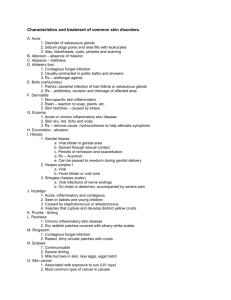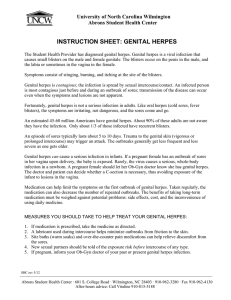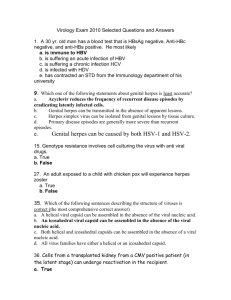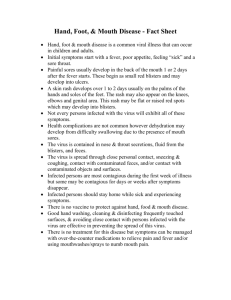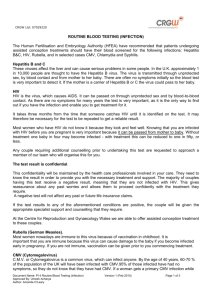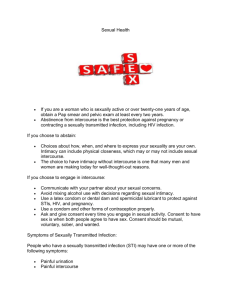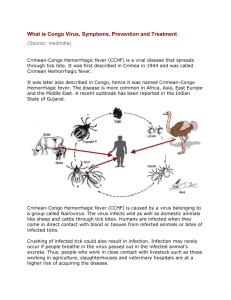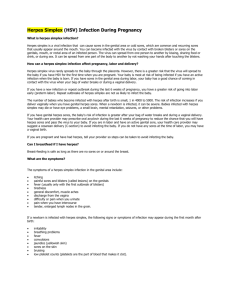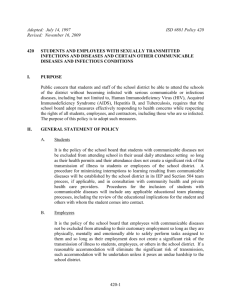SEXUALLY TRANSMITTED DISEASES (STDS)
advertisement
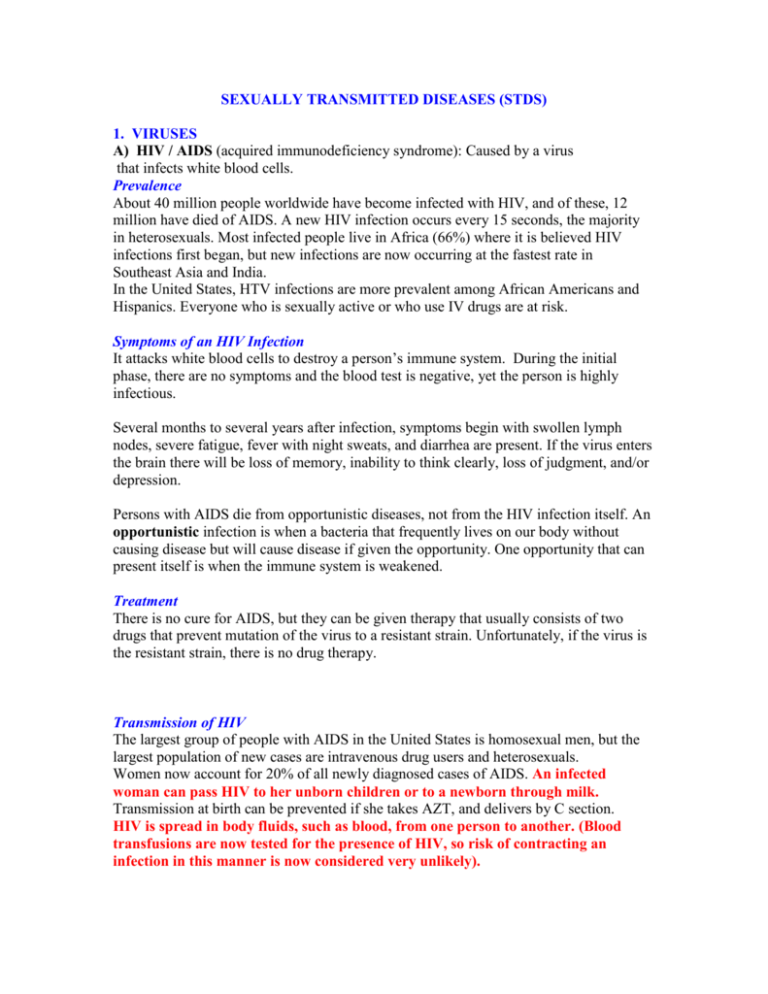
SEXUALLY TRANSMITTED DISEASES (STDS) 1. VIRUSES A) HIV / AIDS (acquired immunodeficiency syndrome): Caused by a virus that infects white blood cells. Prevalence About 40 million people worldwide have become infected with HIV, and of these, 12 million have died of AIDS. A new HIV infection occurs every 15 seconds, the majority in heterosexuals. Most infected people live in Africa (66%) where it is believed HIV infections first began, but new infections are now occurring at the fastest rate in Southeast Asia and India. In the United States, HTV infections are more prevalent among African Americans and Hispanics. Everyone who is sexually active or who use IV drugs are at risk. Symptoms of an HIV Infection It attacks white blood cells to destroy a person’s immune system. During the initial phase, there are no symptoms and the blood test is negative, yet the person is highly infectious. Several months to several years after infection, symptoms begin with swollen lymph nodes, severe fatigue, fever with night sweats, and diarrhea are present. If the virus enters the brain there will be loss of memory, inability to think clearly, loss of judgment, and/or depression. Persons with AIDS die from opportunistic diseases, not from the HIV infection itself. An opportunistic infection is when a bacteria that frequently lives on our body without causing disease but will cause disease if given the opportunity. One opportunity that can present itself is when the immune system is weakened. Treatment There is no cure for AIDS, but they can be given therapy that usually consists of two drugs that prevent mutation of the virus to a resistant strain. Unfortunately, if the virus is the resistant strain, there is no drug therapy. Transmission of HIV The largest group of people with AIDS in the United States is homosexual men, but the largest population of new cases are intravenous drug users and heterosexuals. Women now account for 20% of all newly diagnosed cases of AIDS. An infected woman can pass HIV to her unborn children or to a newborn through milk. Transmission at birth can be prevented if she takes AZT, and delivers by C section. HIV is spread in body fluids, such as blood, from one person to another. (Blood transfusions are now tested for the presence of HIV, so risk of contracting an infection in this manner is now considered very unlikely). B) Herpes Infections The herpes viruses cause various illnesses. Chicken pox and mononucleosis (EpsteinBarr) are examples of a herpes virus. However, only the herpes simplex virus is sexually transmitted. They infect mucosal linings such as the mouth and vagina. There are two types of herpes simplex viruses: type 1 usually causes cold sores and fever blisters, while type 2 more often causes genital herpes. However, oral sex with someone with a fever blister can cause genital herpes and oral sex with someone with genital herpes can cause fever blisters. Cold Sores and Fever Blisters Cold sores are usually contracted during childhood from a smooch from a well-meaning adult with a cold sore. The sores heal and break out again during times of stress throughout the person’s life. The stress can be from emotional stress, illness, menstruation, high fever, colds, or exposure to sunlight. These sores are infectious for at least three to four days until the sores begin to heal. Contact with the sores or any contaminated object can cause the virus to be transmitted. Genital Herpes Genital herpes is what causes genital warts. All warts are caused from a virus. A regular wart on the hands or plantar wart on the feet is harmless, but they can spread, get bigger, and cause discomfort. Genital herpes is a sexually transmitted wart. Over one million persons a year become infected, but not everyone goes in for treatment. It is caused from having intercourse with someone who has genital herpes, or from having oral sex with someone with a cold sore. Transmission and Symptoms In some people there are no symptoms, so many people don’t know they have them. They start as a tingling or itching sensation before blisters appear on the genitals. Once the blisters rupture, they leave painful ulcers that may take as long as three weeks or as little as five days to heal. The blisters may be accompanied by fever, some burning on urination, swollen lymph nodes in the groin, and in women, a copious vaginal discharge. As with cold sores, the blisters come back from the same stress situations. A newborn can become infected by passage through the birth canal so they have to be delivered by C-section. Genital warts are associated with cancer of the genitals. Teenagers with multiple sex partners are very susceptible to genital warts, and more cases of cancer of the cervix are being seen among this age group. Treatment There is no cure for genital herpes. There are some medicines in the form of pills or ointment that disrupt the reproduction of the virus and so relieve the initial symptoms at the first sign of outbreak, but it will always come back later. They can be temporarily removed by surgery, freezing, acid, or laser. However, as with all warts, there is a high likelihood of reoccurrence. Even after treatment, the virus can be transmitted because the wart may look gone, but it lingers in the subdermal tissues. Therefore, abstinence or use of a condom is necessary. C) Hepatitis Infections There are several types of hepatitis. There is no treatment and no cure, but there is a vaccine. Hepatitis A This is a virus you get when you or a food worker doesn’t wash the hands after going to the bathroom, and then you eat. It can also be sexually transmitted through oral/anal contact. Hepatitis B This is the form that is primarily spread by sexual contact or sharing needles by drug users. Only about 50% of infected persons have flu-like symptoms, including fatigue, fever, headache, nausea, vomiting, muscle aches, and dull pain in the upper right of the abdomen. Jaundice, a yellowish cast to the skin, can also be present. Some persons have an acute infection that lasts only three to four weeks. Others have a chronic form of the disease that leads to liver failure and a need for a liver transplant. Hepatitis C This is the form you get from infected blood. It is very serious and can lead to chronic hepatitis, liver cancer, and death. Since there is NO TREATMENT for an HBV infection, PREVENTION is imperative by a vaccine, which is safe and does not have any major side effects. This vaccine is now on the list of recommended immunizations for children. 2. BACTERIA Bacterial diseases are controlled by preventing transmission and by antibiotics. Abstinence or monogamous relations (always the same partner) with someone who is free of an STD will prevent transmission. Otherwise, the use of a condom and avoidance of oral/genital contact is recommended. A) Chlamydia Chlamydia is the leading STD in the United States. There are about 6 million new cases per year. Five times more women than men go in for treatment for this because women have more symptoms and men who are infected don’t know it. Symptoms At first there may be no symptoms, but after 1-3 weeks there may be a mild burning sensation on urination and a mucous discharge in vagina. Unfortunately a physician mistakenly may diagnose it as a urinary tract infection and prescribe the wrong type of antibiotic; until they realize the medicine is not working, the person is still contagious. If the infection spreads to the ovaries, pelvic inflammatory disease (PID) results. This is a very painful condition with no treatment and no cure. It also causes sterility. The woman has to live with this severe pain for the rest of her life. If a newborn comes through the birth canal of a women with Chlamydia, its eyes become infected and results in blindness. This is the leading cause of blindness in third-world countries. That is sad, because all it requires are some eye drops in the infant right after birth, and it will prevent this. This STD is easily cured with tetracycline. B) Gonorrhea Gonorrhea was at an all-time high in 1978, but it’s going down now. Women using birthcontrol pills or an IUD have a greater risk because they cause the genital tract to be more receptive to pathogens. Symptoms Unlike Chlamydia, gonorrhea symptoms are more obvious in men than in women. Men have pain on urination and a milky urethral discharge three to five days after contact. In women, there are usually no symptoms until after it spreads to the ovaries, again causing PID (a million women a year get this). Since PID scars up the area around the ovaries, pregnancy can result in an ectopic pregnancies. The leading cause of blindness in newborns is from Chlamydia infections in their eyes after passing through an infected birth canal. Adults can get it in their eyes, too, if they touch an infected area and rub their eyes. Eye infections cause blindness. Oral/genital contact can cause infection of the mouth, throat, and the tonsils. Gonorrhea can spread to internal parts of the body, causing heart damage or arthritis. Transmission and Treatment The chances of getting a gonorrheal infection are good. Women have 50—60% risk, while men have a 20% risk of contracting the disease after even a single exposure to an infected partner. Painful urination usually indicates gonorrhea. It is easily cured using antibiotics. C) Syphilis Syphilis is caused by a bacterium that has a tail and can move, so it is particularly nasty. Syphilis has three stages. 1) Primary stage: an ulcerated sore with hard edges appears at the site of infection. The ulcer heals itself, but it is just gearing up for the next stage. 2) Secondary stage: the bacteria spread throughout the body and a rash forms all over, although it is not itchy. Again, it heals itself, but the worst is on its way. 3) Tertiary stage: lasts until the patient dies. It weakens the arteries, causing aneurysms, and is known for attacking the brain. Symptoms include mental impairment, blindness, and insanity. Henry VIII died from syphilis. Diagnosis and Treatment Diagnosis of syphilis can be made by blood tests and microscopic examination of fluids from lesions. It is easily cured by penicillin, but once it enters the last stage, there is no cure and is fatal. 3. Other Organisms that cause Sexually Transmitted Diseases A) Trichomonas is a single cell parasite which is transmitted sexually and causes severe itchiness a woman’s vagina. Men are usually asymptomatic (no symptoms). B) Fungi and Yeast are pathogens from the plant kingdom. When a woman takes an antibiotic while using birth-control pills, it disrupts the normal balance of bacteria, and allow normal yeast there to cause an infection. C) Lice are insects that can infect the hair of humans. Head lice is well known for infecting the hair of schoolchildren; lice on the pubic hair are called “crabs”, and are sexually transmitted and also can be contracted by contact with an infected person’s clothing or bedding. They suck blood from their host and cause severe itching, particularly at night. The pubic hair, underarm hair, and even the eyebrows can be infected, and it can be self-diagnosed by examination of the hair. Protozoa, yeast, worms, and lice are all easily treated with antibiotics and disinfection of sheets and clothing. Prevention is still the best way to manage STDs. 1. The use of a condom along with a spermicide that contains nonoxynol-9 2. The avoidance of oral/genital contact 3. Have a monogamous relationship 4. Don’t have sex with someone who has a STDs 5. Don’t have sex with an intravenous drug user.
